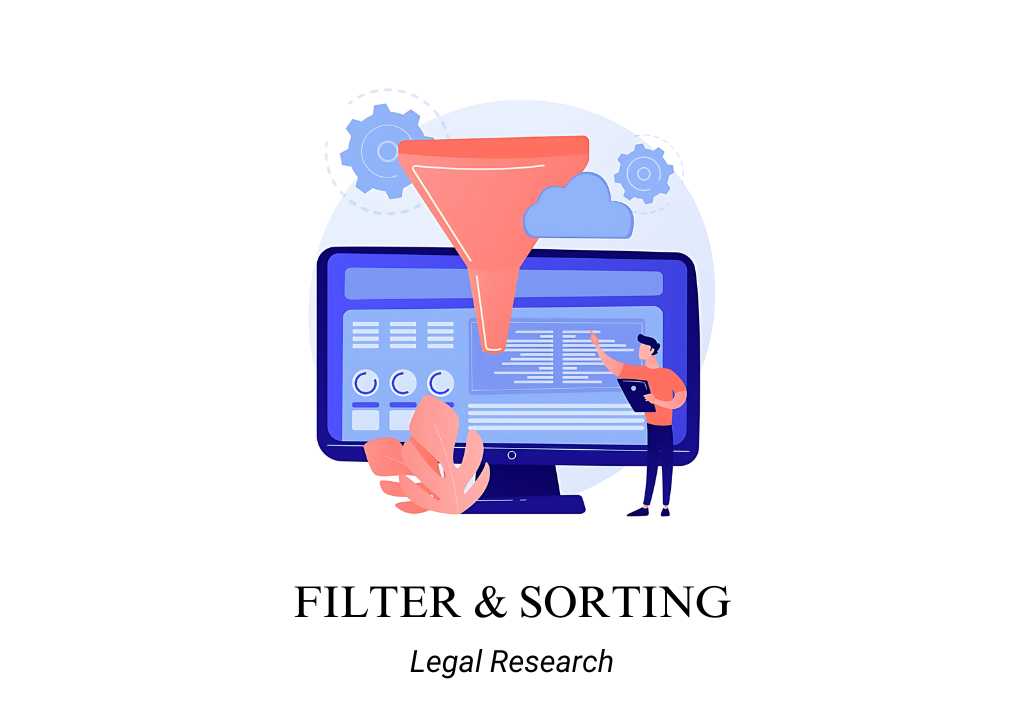Introduction
Meaning
Filter and sorting functionality in legal research tools is designed to help users manage and refine large volumes of legal documents, case law, statutes, and other legal materials. By applying specific criteria, users can narrow down search results to the most relevant information, ensuring efficiency and accuracy in legal research. This process involves categorizing documents based on various attributes like jurisdiction, date, relevance, and publication type, and then sorting the results in a manner that best suits the user’s needs. This functionality is essential for making sense of the vast amount of legal information available, ensuring that legal professionals can find and utilize the most pertinent resources.
Purpose
The purpose of filter and sorting functionality is to streamline the legal research process by allowing users to quickly and easily locate the most relevant legal documents. This helps legal professionals save time, avoid information overload, and focus on the most critical materials for their cases. By providing a structured way to sift through data, this functionality ensures that legal teams can build stronger, more informed arguments and stay compliant with legal standards.
Benefits
- Targeted Search Results: Ensures that users can narrow down their searches to only the most relevant documents, reducing the time spent sifting through irrelevant information.
- Efficiency: Streamlines the research process by enabling quick access to the most pertinent legal materials, allowing for faster decision-making and case preparation.
- Improved Accuracy: Helps users focus on highly relevant sources, improving the accuracy and quality of legal research.
- Customization: Allows users to customize their search criteria based on specific needs, such as jurisdiction or date range, ensuring that the results align with their unique requirements.
- Enhanced Usability: Improves the user experience by organizing search results in a clear and manageable way, making it easier to locate and utilize key legal documents.
CHECK MORE: Guide to find best Legal Research Tools
Features
Jurisdiction and Court Level
Meaning:
Jurisdiction and court level filtering allows users to refine their search results by specifying the legal jurisdiction (e.g., federal, state, or international) and court level (e.g., trial court, appellate court, or supreme court). This feature is crucial for legal professionals who need to focus on case law and legal materials that are relevant to a specific geographic area or court hierarchy.
Purpose:
The purpose of jurisdiction and court level filtering is to ensure that legal research is geographically and hierarchically relevant. By limiting searches to specific jurisdictions or court levels, legal teams can avoid irrelevant information and focus on the legal precedents and rulings that are most applicable to their case.
Use Cases:
- State-Specific Litigation: A lawyer working on a state-level case uses jurisdiction filtering to focus only on case law and statutes relevant to that state, ensuring that all references and precedents align with local laws.
- Supreme Court Appeals: An appellate lawyer filters search results to only include decisions from the Supreme Court, ensuring that the research is directly applicable to the highest level of legal authority.
Date Range and Publication Type
Meaning:
Date range and publication type filtering allows users to narrow down search results based on the time frame and type of legal publications they are interested in. This can include filtering by specific years, recent publications, or types of documents such as case law, statutes, legal articles, or court opinions.
Purpose:
The purpose of this feature is to ensure that legal professionals can focus on the most current or historically relevant legal materials, depending on the needs of their case. It helps users avoid outdated or irrelevant information and ensures that the most appropriate and timely legal sources are consulted.
Use Cases:
- Recent Case Law: A lawyer researching recent developments in a specific area of law uses date range filtering to find only the most recent case law, ensuring that their arguments are supported by the latest legal precedents.
- Historical Research: A legal scholar conducting research on a historical legal issue uses date range filtering to focus on cases and statutes from a specific time period, ensuring that their analysis is historically accurate.
Relevance and Citation Frequency
Meaning:
Relevance and citation frequency sorting enables users to organize their search results based on the importance and influence of the documents. Relevance sorting typically ranks results by how closely they match the search query, while citation frequency sorting prioritizes documents that have been cited frequently in other legal cases or publications.
Purpose:
The purpose of relevance and citation frequency sorting is to help legal professionals prioritize the most critical and influential legal materials. By focusing on highly relevant or frequently cited documents, users can ensure that their research is based on authoritative and widely recognized sources.
Use Cases:
- Legal Argumentation: A lawyer preparing a legal brief uses relevance sorting to find the most pertinent case law and statutes related to their argument, ensuring that their research is focused and directly applicable.
- Influential Precedents: A legal researcher sorts search results by citation frequency to identify the most influential cases in a particular area of law, ensuring that their analysis is grounded in well-established legal precedents.
Conclusion
These features within the filter and sorting functionality are essential for enhancing the efficiency, accuracy, and relevance of legal research. By leveraging these tools, legal professionals can effectively navigate large volumes of information, ensuring that they have access to the most pertinent legal resources for their cases.
CHECK OUT LEGAL RESEARCH TOOLS ON DIRECTORY OR CLICK HERE


